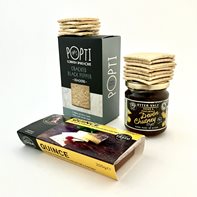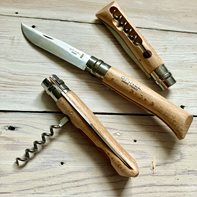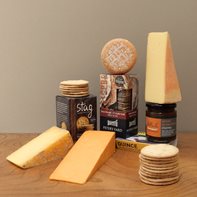
Ogleshield
Sometimes one cheese leads to another. Here's the story:
Once Upon a Time Jamie Montgomery - maker of the famous cheddar - played host to two young Americans keen to learn about cheesemaking. They experimented with some of his Jersey milk - not generally used for cheddar - using various techniques, and the result of one of their more successful ideas led to Jersey Shield.
Up at Neal's Yard Dairy, the storeman Bill Oglethorpe began to experiment with the cheese, using the washed rind technique which affects texture, taste, smell (more!), and the quality of the rind (softer, stickier). You can guess the next bit: Oglethorpe's modified Jersey Shield became 'Ogleshield'.
Unpasteurised, not vegetarian.
Montgomery's
On a grey and rather uninspiring February day I rounded the slopes of the iron age Cadbury Castle and turned into the yard at Manor Farm, where I met Jamie in the farm office. He explained that his grandfather had arrived in 1911 to find they were already making cheese, about which he became quite enthusiastic. This enthusiasm was passed on to Jamie's mother, and - in due course - to him.
I was keen to know how their present day star status had been achieved. Jamie took me back to the late 80s/early 90s when prospects looked bleak. There was little interest in what we now call 'artisan' cheese; conventional wisdom decreed - not unreasonably - that supplying the supermarkets was the only route to survival. A brief contract with Tesco ended when they de-listed the cheese without taking the trouble to tell Jamie, who only found out when the pallet of cheese he'd prepared for them wasn't collected (Tesco, ruthless? I refuse to believe it). Unsurprisingly, he decided that there was no future in that direction.
But a series of events in the later 90s proved pivotal. First came the double Gold Medals for Best Cheddar and Best Traditional British Cheese at the 1996 British Cheese Awards; this was followed in '97 by a BBC Food And Drink programme ("the phone rang non-stop for days"). Then there was the Great Cheese Theft. This potential nightmare - thieves broke into their store and took £35K worth of cheese - turned into a publicity bonanza for Jamie: journalists loved the story of the heist targeting "the best cheddar in the world". Soon, he started to notice that the press were speaking about 'Montgomery's Cheddar' with no need for further explanation. In other words, they'd arrived.
The Montgomery approach is about rigorous attention to detail and an absolute refusal to compromise in pursuit of the very best. This involves a set of core principles (unpasteurised milk from their own herd, animal rennet, very special starter bacteria, cloth binding, maturation on wooden shelves etc), but also staying alert to the different needs of every batch. Jamie's very clear that the process should never become fixed, and as if to illustrate this, he breaks off to discuss the day's batch with two of his makers, which is taking its time developing the necessary acidity. The point is that every batch is different; the makers need to stay alive to this, making tiny adjustments to the process as needed.
The cheddar was joined some years ago by washed rind delight Ogleshield. This uses the creamy Jersey milk from Jamie's 'other' herd (there are Friesians for the cheddar), and has a wonderful sticky, soft rind.
A really enjoyable trip; Jamie comes second to no one in his enthusiasm for cheese, is proud of his team and their joint achievements. He's not looking to massively increase sales, just to keep the job interesting and to keep doing it well.














